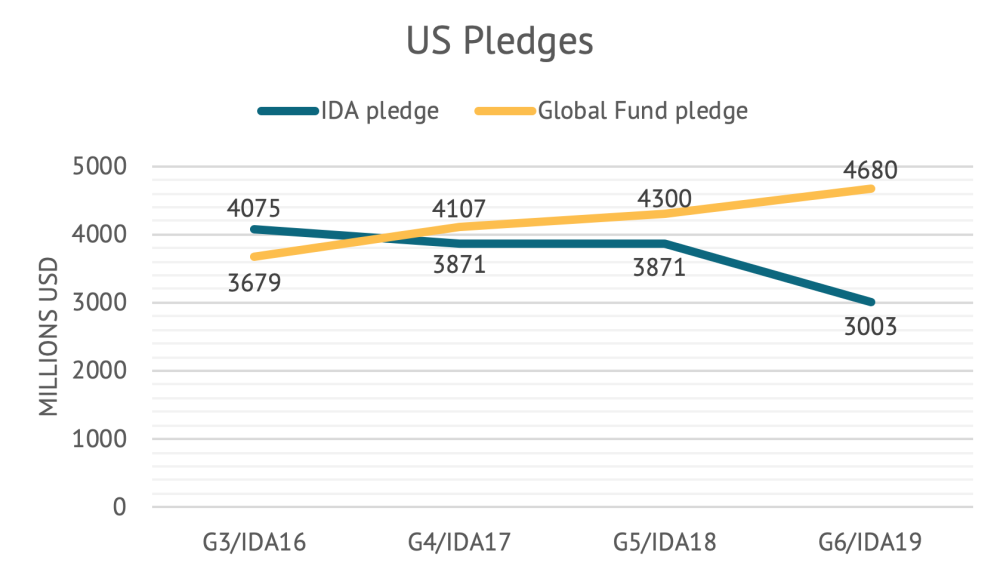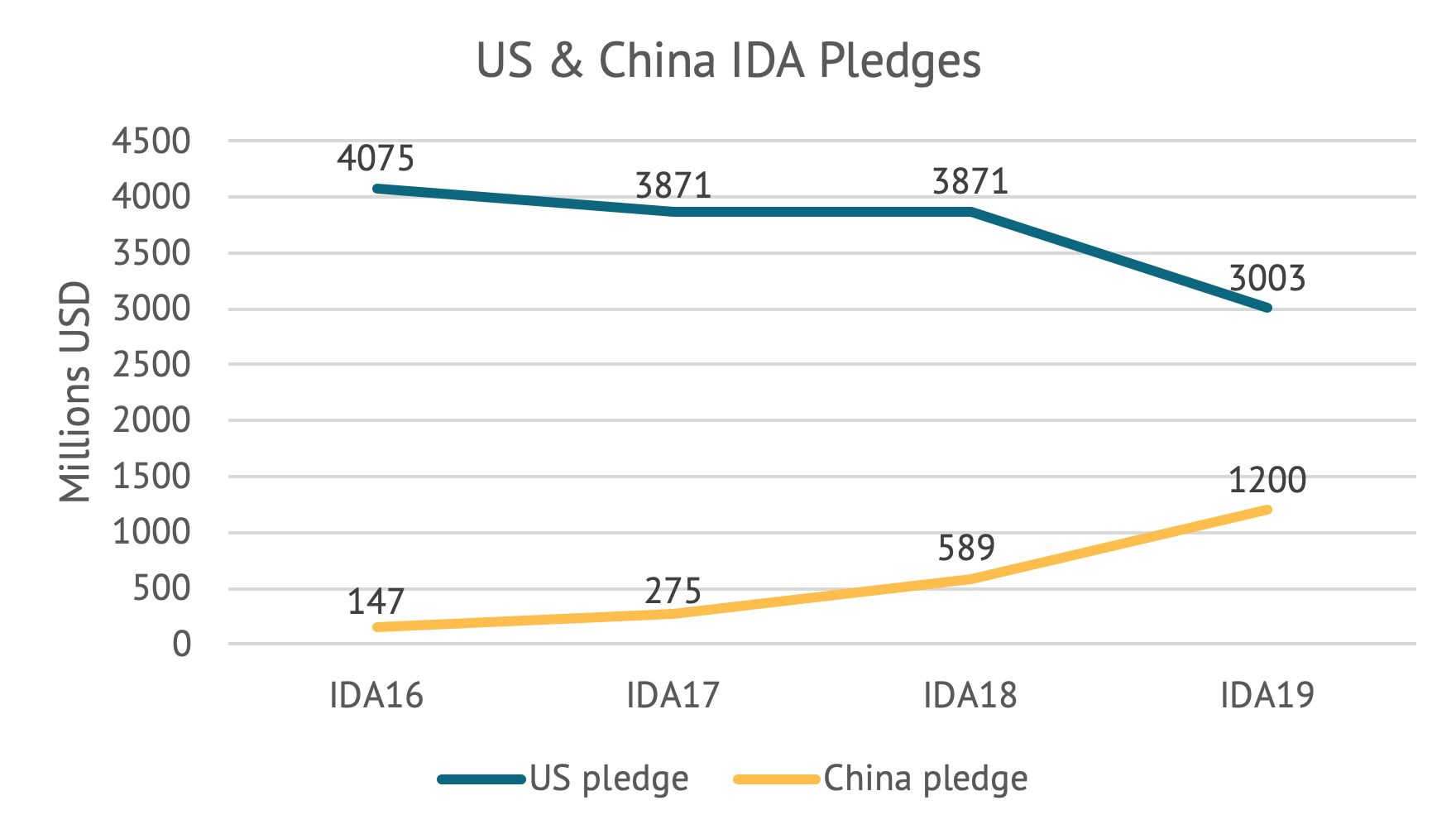The World Bank’s International Development Association (IDA) has long played the central role in the international aid architecture, if by no other measure than its scale of financing for the world’s low-income countries. IDA’s most recent round of fundraising generated a record-setting $82 billion for programming over the next three years. This pot of money, representing $27 billion in annual programming for eligible countries, preserves IDA’s role as the largest source of development assistance in the world.
By comparison, the Global Fund, a multilateral financing mechanism focused on the treatment and eradication of AIDS, tuberculosis, and malaria, raised $14 billion to enable $4.7 billion in annual programming over the next three years. Clearly IDA is much bigger than the Global Fund, so why bother to compare the two, particularly in terms of fundraising prowess?
The comparison is apt because the headline numbers obscure a trend in contributions from the United States that could greatly alter the relationship of donors to the multilateral system, particularly if other donors follow suit. When it comes to the United States, the reality is that the Global Fund is winning the fundraising game hands down.
After a steady decline in US contributions since IDA’s sixteenth replenishment in 2010, and a steady rise in contributions to the Global Fund over the same period, the United States now gives 50 percent more to the Global Fund than to IDA. Overall, IDA donor contributions are down, from just over $24 billion in 2010 to $23 billion today, while Global Fund contributions have risen steadily from $12 billion then to $14 billion today.
When it comes to donor behavior, the United States may prove to be the 800-pound canary in the coal mine, both providing an early indicator of larger trends and large enough itself to shape those trends. In an era when the overall envelope of donor contributions is not growing (at least from traditional donors—more on that later), the allocation of existing contributions has direct bearing on the multilateral institutions themselves. To put it bluntly, when it comes to fundraising from donors at a time of fixed resources, there will necessarily be winners and losers, with a decision to allocate more to one replenishment (Global Fund) most likely entailing a decision to reallocate away from another (IDA).
Whether or not this matters depends on how you view the multilateral architecture. The Global Fund’s success with donors rests on activities that are focused on key donor priorities, in this case addressing three leading diseases in the developing world. IDA plays a different role. To the degree donors have preferences (health, education, infrastructure, agriculture, etc.), IDA seeks to address all of them to varying degrees. More to the point, IDA allocates funding according to the priorities of its low-income client countries. Historically, donors themselves have viewed this approach to priority setting as a priority in itself. But the behavior of the United States in recent years suggests that donor support for this model is weakening in favor of issue-driven aid.
Focusing on diseases (or agriculture or education) is not bad for development. But a multilateral architecture that favors this donor-driven approach over a clearer leadership role for developing countries themselves marks a return to some of the problems that the donor community sought to correct for in earlier times: lack of developing country buy-in; a tendency toward fads in aid allocation; and/or a set of priorities that do not actually serve broader development needs.
Add to this list the fact that IDA’s broader approach tends to support the goals of issue specific funds like the Global Fund—in this case, supporting health system strengthening and sector reforms in developing countries that are needed to make progress on disease elimination. IDA’s “systems” approach is all the more relevant to US objectives at a time when US policy aims to support countries on a “journey to self-reliance” and, in the case of PEPFAR, HIV epidemic control is intended to trigger the transition to domestic funding for the HIV response.
The politics of the trend in US contributions are easy to appreciate. It is much easier to explain to congressional funders the objectives of a dollar to the Global Fund, defined by three diseases, than it is to explain what IDA does and how it does it.
Finally, there’s another striking donor trend that emerges from the IDA and Global Fund replenishments. Perhaps the biggest surprise of the IDA replenishment was China’s decision to double its contribution.
Contrast that with the country’s longstanding indifference to the Global Fund. Clearly the world’s most important emerging donor views the multilateral architecture differently than the world’s most important traditional donor does.
There’s no reason we should expect the two countries to act the same way on these matters, or more to the point, that the United States should take its cues from China. Nonetheless, as Washington espouses Great Power competition, one has to wonder if the shift in US funding priorities resonates with developing countries as strongly as China’s big moves in IDA and the other multilateral development banks.
Going forward, as in other realms of finance and politics, the behavior of the United States and China as multilateral donors will continue to shape the entire multilateral system. It would be best for the objectives of IDA and the Global Fund, not to mention the African Development Fund, IFAD, GAVI, the Global Partnership for Education, etc., if these two donors fully embraced the potential of multilateralism. Both countries continue to greatly favor bilateral aid over multilateral mechanisms in relation to other major donor countries. A shift in mindset in the US and China would mean less pitting of one multilateral institution against another, and a stronger embrace of the multilateral ambition needed to address today’s global challenges.
Disclaimer
CGD blog posts reflect the views of the authors, drawing on prior research and experience in their areas of expertise. CGD is a nonpartisan, independent organization and does not take institutional positions.








